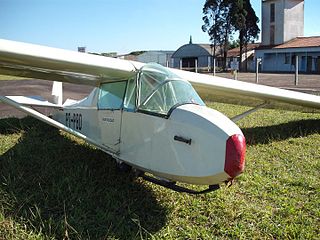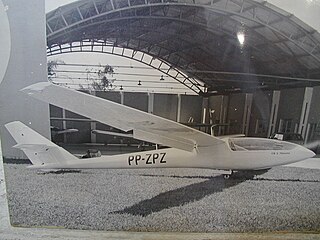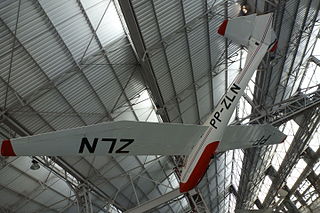
The Schleicher ASW 15 is a single-seat sailplane designed in 1968 by Gerhard Waibel and manufactured by Alexander Schleicher GmbH & Co. The ASW 15 has shoulder-mounted wings and an all-flying tailplane, with its single tow-release placement a compromise between winching and aerotowing. The later ASW 15B had several improvements, including a tow-release placed on the plane of symmetry, an 11 cm taller rudder, a slightly larger main wheel, and the provision of a 90-litre water ballast system.

The Scheibe Spatz is a German glider with a mixed metal and wood construction that was built in 1952 until 1962. Later versions were known as the L-Spatz, the letter L standing for Leistung, which is German for "performance".

The ACS-100 Sora is a Brazilian two-seat Light Sport Aircraft, designed by Advanced Composites Solutions.

The Fauvel AV.36 was a single-seat tailless glider designed in France in the 1950s by Charles Fauvel. Although the "AV" in AV.36 stands for Aile Volante, it was not a true flying wing: it featured two large fins mounted on stubby tailbooms extending back from the wing's trailing edge, and accommodated the pilot within a stubby fuselage. The aircraft was designed to be quickly disassembled for road transport, with the nose detaching, and the fins able to fold back against the trailing edge of the wing. A refined version with a slightly longer wingspan, the AV.361 was introduced in 1960.
The ICA IS-32 is an open class high-performance metal two-seat sailplane produced in Romania in the 1970s. A refinement of the IS-28B, it shared most of that aircraft's fuselage, mated to new wings and empennage. This new wing had a span of 20 metres, featuring interconnected ailerons and flaps, Schempp-Hirth-type airbrakes. It had no provision for water ballast. The monowheel undercarriage differed from the IS-28 in being fully retractable.

The Neiva B Monitor, also designated B-2, is a Brazilian tandem two-seat glider aircraft designed and manufactured by Indústria Aeronáutica Neiva between 1945 and 1955 for primary training and general flying.
The PIK-3 was a sailplane produced in Finland in the 1950s and 60s. It was designed to be a cheap and easy-to-build aircraft to equip the country's gliding clubs as their standard single-seat machine. It was a conventional design for its day, with a high wing and conventional empennage. Construction was of wood throughout, skinned in plywood.

The IS-5 Kaczka was a single-seat canard research glider designed and built in Poland from 1948.

The CEA 102 CB.2 Minuano is a high performance sailplane designed by Claudio Barros and developed by the Centro de Estudos Aeronáuticos - at the Escola de Engenharia da Universidade Federal de Minas Gerais (EEUFMG) - in Brazil between 1969 and 1975.

The Johnson RHJ-6 Adastra was an American mid-wing, two-seat glider that was designed and constructed by Dick Johnson and first flown on 3 April 1960.

The Hütter Hü 17, is a German high-wing, strut-braced, single-seat, utility training glider that was designed by brothers Ulrich Hütter and Wolfgang Hütter in the 1930s.

The Embraer EMB 400 Urupema initially called IPD 6505 Urupema, is a Brazilian glider developed at Instituto Tecnológico de Aeronáutica, São José dos Campos, in 1964, and later produced by Embraer.
The CETEC-303 CB.7 Vesper is a Brazilian motor glider designed by Cláudio de Barros.
The CEA-308 is a Brazilian sports aircraft designed by Paulo Iscold, that beat four FAI World Records with pilot Gúnar Armin Halboth.
The CEA-309 Mehari is a Brazilian single-seat, monoplane sports aircraft developed by CEA.
The IPT-5 Jaraguá, was a Brazilian two-seat in tandem-seat configuration, monoplane, sailplane aircraft designed and manufactured for general flying.
The HW-4 Flamingo, was a Brazilian two-seat in tandem-seat configuration, sailplane aircraft designed and manufactured for general flying.
The IPT-6 Stratus, was a Brazilian single-seat, was a high-performance two-seat, high-wing sailplane.
The IPD Urubu also known as the IPD/PAR PE 80367, was a two-seat sailplane of high-wing.

The IPD Periquito, was a single-seat sailplane of high-wing construction designed in 1956 by Guido Pessotti in Brazil.
This page is based on this
Wikipedia article Text is available under the
CC BY-SA 4.0 license; additional terms may apply.
Images, videos and audio are available under their respective licenses.











